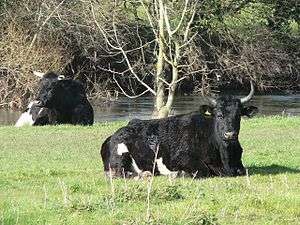Shetland cattle
|
Shetland cattle in a pasture | |
| Country of origin | Scotland |
|---|---|
| Distribution | Scotland |
| Use | Beef, dairy and draft |
| Traits | |
| Weight | Male: 550 kg |
| Female: 350 kg | |
| Coat | White spots upon black |
| Horn status | Horned |
|
Cattle Bos primigenius | |
Shetland cattle are a small, hardy cattle breed from the Shetland Isles, located off the northeast coast of Scotland. They are noted for their use in crofting in Shetland, where they provided use for meat, milk and draft work (pulling ploughs). Despite the rapid decline in crofting for a living, efforts to conserve this breed in the United Kingdom are mainly done by the Shetland Cattle Breeder's Association.
Like most breeds originating from Shetland, the cattle are smaller than most. This characteristic is attributed to the hard climate of their native environment. They are normally black and white in colour but there are smaller numbers in grey, red and dun.
Characteristics
Shetland cattle are usually black and white, similar in colour to the Holstein Friesian breed. However, an estimated 10 percent are red and white, while a small but growing percentage are dun and grey.[1] The cows are typically smaller than most, ranging from 350 kg (770 lb)—450 kg (990 lb), while the bulls range from 550 kg (1,210 lb)—600 kg (1,300 lb). They are regarded as small in size by most breeders and organizations. Their horns curve upwards, but these are trimmed during commercial production.[2]
A long hairy coat protects the cattle during the winter, but this recedes during the summer months. Many breeders see many desirable traits in Shetland cattle, such as easy calving and fast growing to adult size.[3]
History
The Shetland Cattle are considered an ancient breed, by most organisations because they date back to the Viking Era. It is believed that they first arrived between 700 and 1100 AD and have since experienced many other influences, such as cross breeding.[1]
They were once an important species in Scotland for their hardiness, Shetland cattle experienced a sharp population decline through the 19th century, with an estimated population of 15,000 cattle nearing extinction by the middle of the 20th the importing of larger breed bulls proved more popular with local crofters.[2][4][5]
In 1834, the cattle were described by author William Youatt in his book, Cattle: Their Breeds, Management, and Diseases. They were described as 'living on their native moors' and being 'housed every night'. He also records the population in the 1800s. The book reads 'forty years ago [c. 1800] 3000 cows, 1000 oxen and 10,000 young cows inhabit.' However, now 'more than 44,000 inhabit these islands'. It is unknown what proportion of these cattle were cows, oxen or calves.[6]
While the Shetland could thrive on inhospitable lands, the evolution of agricultural practices and chemicals made grass more plentiful for less hardy breeds, and these larger bulls could sire calves that would grow larger and more quickly.[7][8] Increasing the size of the cattle was attractive in the aftermath of John Boyd-Orr's influential studies in the 1930s, which revealed a deficiency in the "midst of plenty" among the United Kingdom's urban proletariat, whose diet lacked meat.[9]
As farming moved towards a more intensive production method, Shetland cattle numbers fell dramatically. This was combined with the loss of subsidies from the 1940s government. In 1950, only 40 pure bred cows were left.[3]
During the Falklands War, five pregnant cows and one bull were sent to the Falkland Islands, to replace livestock killed in the conflict. They were sent by the Rare Breeds Survival Trust, which surprised many, given how rare the cattle were. At this time, only 121 adult cows were registered and this was seen as a way to boost numbers.[10]
Present
Efforts are underway to restore the Shetland breed, notably by the Shetland Cattle Breeder's Association, a group of mainland breeders who provides assistance to its members concerning genetic records, breeding plans, husbandry, and the location of Shetland breeders. The association also provides advertising services for its members.[11]
Shetland cattle are currently used as a meat cattle in speciality, niche markets. These cattle are usually kept on small scale farms that rely on a high income from the sale and low maintenance costs for feed. The cattle is also still kept by a very small numbers of self-sufficient people in Shetland.[8] There are currently 800 registered breeding cows and an average for 180 calves born each year.[2]
See also
References
- 1 2 "The Beef Site — Shetland Cattle". The Beef Site. Retrieved 6 September 2015.
- 1 2 3 "SCBA – About Shetland Cattle". www.shetlandcattle.org.uk. Retrieved 13 April 2015.
- 1 2 "Breed Focus Shetland Cattle". Pocket Farm. Retrieved 8 September 2015.
- ↑ "Shetland Cattle Herd Book Society – History". Retrieved 6 September 2015.
- ↑ "RBST — Shetland Cattle". Rare Breeds Survival Trust. Retrieved 6 September 2015.
- ↑ Youatt, William (1834). Cattle: Their Breeds, Management and Diseases. Baldwin and Cradock. p. 85.
- ↑ "History of Shetland Cattle". Greenoak Shetland. Retrieved 6 September 2015.
- 1 2 "Shetland Cattle in the 20th Century and Today". The Smallholder Series. Retrieved 6 September 2015.
- ↑ Food Health And Income. Report On The Adequacy Of Diet In Relation To Income. Boyd Orr, MacMillan 1936
- ↑ "Viking Descendants to Land in the Falklands". New Scientist. 3 November 1983. Retrieved 6 September 2015 – via Google Books.
- ↑ "Shetland Cattle Breeder's Association". Retrieved 4 May 2009.
